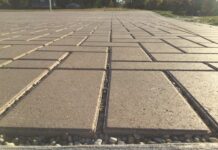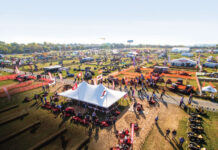It doesn’t necessarily take a village to make a great retaining wall, but for Gib Lyttle having a little help from some knowledgeable friends made a big difference on what could have been a very difficult project.
Lyttle, the managing member of Delta Development North Carolina in Raleigh, North Carolina, was called in to be the turnkey site contractor for Georgia-based Davis Development on a 20-some-acre mixed-use project known as Weston Corners in nearby Cary, North Carolina.
“We did the retaining walls, the grading, the utilities and the roadway installations,” Lyttle says. “There were approximately 150,000 yards of dirt to move to grade the site and about 75,000 yards of rock that required blasting. It wasn’t a small job.”

Almost from the beginning, the retaining wall on one side of the property offered some major challenges. Designed by Erwin Williams of Raleigh-based TerraTech Engineers, Inc., the 30-foot-tall wall was intended to be cast-in-place, with a brick veneer.
“When the estimates came in for that, they were very cost-prohibitive,” Lyttle says. “That’s when Erwin and the developer and I got together, and I suggested we look at an Allan Block palette to see what we could accomplish.
Under normal circumstances, selecting an attractive block product and going with it probably would have been the end of the story. However, the wall’s location offered several complications beside the 30-foot height.

For one thing, the wall needed to be installed immediately adjacent to the project’s property line which eliminated the opportunity to dig off-site and install geogrid. Not only did Davis Development not have permission for that, but right behind the wall’s location is an easement for a fuel transmittal line, which would have created its own problems.
On top of that, the new wall was going to be installed against native rock, which would require blasting for the full depth.
Lyttle says what he suggested, and what Williams and TerraTech ultimately designed, was a shotcrete wall with soil anchors, with the Allan Block tied into the shotcrete wall. Even then, the project didn’t enjoy completely smooth sailing.

Lyttle explains that the shotcrete wall was constructed from the top down as the rock and earth were blasted away. As part of that, metal soil anchors were drilled in. However, when the excavation got to approximately the 25-foot level, the Delta Development crew encountered excessive groundwater.
“We had to go back to Erwin at TerraTech,” Lyttle says. “He augmented his wall design to include a PVC- (polyvinyl chloride) and-concrete drainage system for that bottom five feet, so that impacted us, as well.”
The drainage system then ties into the storm drainage system Delta Development installed under the project’s roadway system which drains into a landscape and erosion control pond.

While this was going on, Lyttle was working with Fay Block Materials, Inc., in Fayetteville, North Carolina, Bart Hardison and Chris Barr — his representatives there — and Allan Block corporate to get an aesthetically pleasing design, as well.
“Because we wanted some visual breaks in it, there are pilasters about every 45 feet, which are a different, oversized Allan Block, that we used to give the surface a bit of relief,” Lyttle explains. “They extend an inch-and-a-half beyond the face of the wall, so it looks like integrated columns. Once they get to grade at the top of the wall, they turn into actual columns with a precast cap on them. For the rest we used a four-piece multi-sized system in three different colors, so it’s quite a unique wall.”
The remainder of the wall has a standard wall cap, and is topped with an anodized black aluminum fence that was core drilled into it.

Again, because of the location of the wall, Lyttle says construction was complicated. Work had to be done almost entirely from the front side, which required an extensive use of lifts to get materials – including stone for backfill – and manpower up and down, as well as additional safety concerns and adaptations for construction.
“It was slower going than what we might normally have had,” he says.
Lyttle adds that total construction of the wall – including the blasting and Shotcrete application – took between three and four months, utilizing a crew of 12-15 under the direction of Clemente Balthazar and managed by Bill Amsden. Construction of the block wall took approximately six weeks of that.
Nor was the lack of space behind the wall the biggest challenge the job faced. Even as the team worked, they were constrained on the front side by construction of a five-story parking deck that was going on within 30 feet of the worksite.

“That was a big challenge,” Lyttle emphasizes. “There was a lot of coordination that had to be done. A lot of our challenges we were able to design away, but there was definitely a problem with space constraints.”
Still, Lyttle says he was a bit surprised when he was notified that the wall had won the award for segmental retailing walls – commercial at last fall’s Hardscape North America competition.
“It’s a hell of a wall and quite impressive because of its size and because of the aesthetics and design portions of it,” he says.
As an experienced contractor, Lyttle says the job wasn’t exactly a learning experience, but it did call on a lot of his (and others’) previous knowledge and experience to figure out some of the aspects of it, particularly with the drainage system.
However, he adds that since the wall was done with the highest quality materials and workmanship, perhaps it’s not too surprising it became an award-winner. What makes him most proud is the teamwork that let it come together.
“I’m proud, not just of my guys, but of the opportunity to team up with Erwin (Williams) and with Bart (Hardison) and Chris (Barr) at Fay Block and all the people at Allan Block who were more than a little involved in some of the aspects of it,” he says. “Everybody worked together to pull it off, and it’s all there.”











![[VIDEO] Dickies®: Discover Workwear That’s Anything But Uniform](https://turfmagazine.com/wp-content/uploads/2023/06/1647663814-4b1a2a7742790a9b1e97a3b963477850192e1d6a9dfba9b07214a77bae25d6e3-d-218x150.jpg)






























![[VIDEO] Dickies®: Discover Workwear That’s Anything But Uniform](https://turfmagazine.com/wp-content/uploads/2023/06/1647663814-4b1a2a7742790a9b1e97a3b963477850192e1d6a9dfba9b07214a77bae25d6e3-d-324x160.jpg)